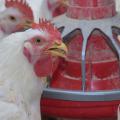Quail Pox
Frequently a series of lesions can be observed on the feet and toes of quail that resist even the best efforts to treat them. The lesions can range from a few dried scabs to complete toe loss. Often the lesions will bleed severely. This problem is most commonly observed in birds raised on wire floors during the autumn season of the year.
Many causes of these type foot problems have been suggested and include insect stings, nutritional deficiencies, injuries and diseases. Actually, the most common cause is a combination of these factors.
The condition is usually started from the bites of mosquitoes while they suck blood from the birds. Mosquitoes enter the house in larger numbers in the autumn when temperatures begin to fall. The feet are the most exposed part of the body because the mosquitoes can attack from beneath the wire floor as the bird sleeps. Birds housed on dirt or litter floors do not have a high incidence of this problem.
After the bite has occurred, the foot becomes inflamed from irritation of the bite or from quail pox virus that is injected by the mosquito. The irritation becomes a discomfort that the bird pecks at and the foot forms a scab from the constant pecking. A reaction to the quail pox disease may also complicate the problem. It can get so severe that toes are often pecked off by the bird itself in an attempt to sooth the irritation.
The best solution to the problem is to prevent it before it occurs. Conduct a good mosquito control program to prevent entry of the insects and use residual insect sprays to kill mosquitos that stay in the house. Vaccinating birds will also reduce the severity of the problem if the virus is passed to the birds. Reducing the light intensity and use of antibiotic therapy may be helpful in reducing the severity. No antibiotic therapy is effective against quail pox but medications may be effective for treating secondary bacterial infections and soothing the injuries.
More information on this disease is available in the Diseases of Poultry section.
Publications
News
STARKVILLE, Miss. -- Until an avian flu vaccine for chickens or other alternative is federally approved, commercial poultry operations in the U.S.
STARKVILLE, Miss. -- If egg prices have seemed higher than ever lately, it’s because they are, and consumers can place much of the blame squarely at the feet of the ongoing bird flu outbreak.
With highly pathogenic avian influenza, or HPAI, in the environment in Mississippi, owners of backyard flocks have to take extra steps to keep their chickens healthy.
Avian influenza poses an extremely low risk to human health and none to food safety in Mississippi, but its presence poses a risk to backyard flocks and the state’s $3 billion commercial poultry industry.






